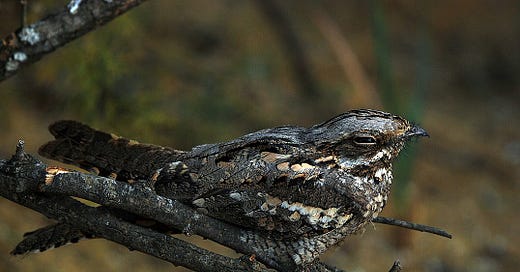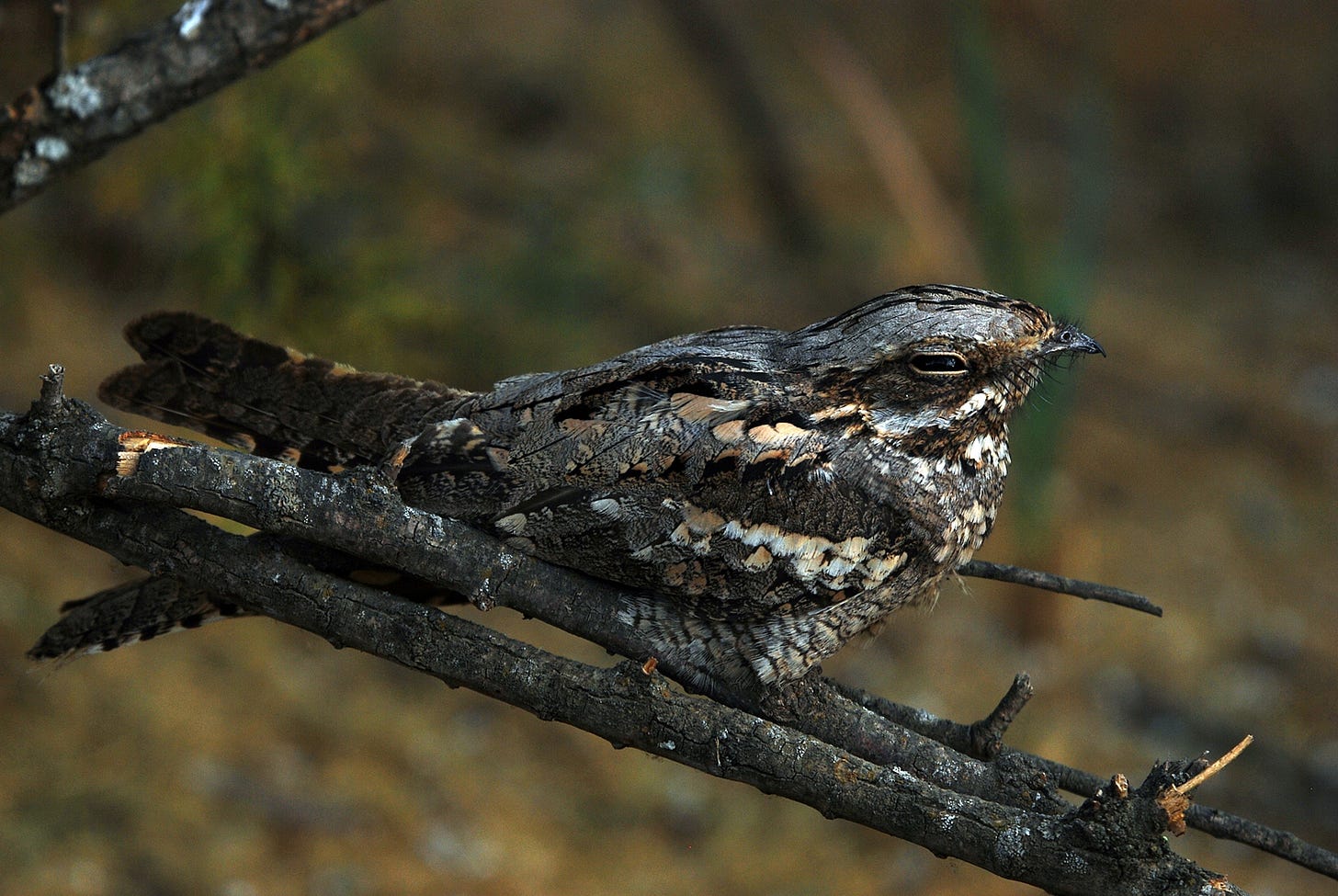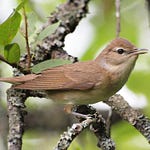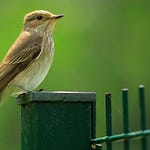The churring of a nightjar seems more electricity substation than birdsong, and its weirdness is amplified by its timing.
Male nightjars sing in the summer months, once the sun’s down.
The sound is two-tone, switching in pitch and intensity, as if adjusted by dials. Think: recently arrived aliens surveilling the landscape with excellent sonic tech.
The persistent churring is often accompanied by a couple of sharper noises. One is a wet-sounding kew-ick, given when they are on the wing. The other the sound of the wings actually being clapped together (you can hear the claps at the very end of the recording above).
With these audible clues, and enough light remaining in the sky, you may catch the silhouette of their slow-winged flight as they patrol the air.
Nightjars need open areas, with low ground cover in which to nest, and plenty of moths and other flying insects to feed on at night. They have a startlingly wide gape, and pronounced, whisker-like bristles around their face to help them locate their prey by feel.
Nightjars are occasionally to be found at rest during the day, when their cryptic plumage allows them blend in with a log, or simply remain undetectable amidst dry bracken and heather.
However, they have a long season of churring, until at least the end of July, in which we can catch their twilight manoeuvres.
The experience of being with nightjars has a special place in many people’s calendars, involving a seasonal visit to heathland, usually with a friend or two for reassurance in the dark.
The act of watching them has a notable place in the history of ornithology too, as told by Tim Birkhead in The Wisdom of Birds.
[Andrew] Selous’s first scientific paper was published in The Zoologist in 1899, and described his observations of a pair of nesting nightjars observed at close range from behind an elder bush. This was extraordinary; no-one (other than hunters), it seems, had watched wild birds like this before, and the results spoke for themselves. The editor of The Zoologist singled out Selous’ unique study for praise and The Saturday Review declared that Selous had exceeded Gilbert White’s observations on the nightjar, referring to him as a ‘born field naturalist’.
There was more to Selous than just watching birds. He had a mission, and saw himself as a pioneer. He wanted to change ornithology, to do away with shooting, collecting and classifying birds, summing up his vision thus: ‘The zoologist of the future should be a different kind of man altogether: the present one is not worthy of the name. He should go out with glasses [binoculars] and notebook, prepared to see and think.’ The idea of giving up the gun in favour of binoculars was ground-breaking indeed. Little wonder the professionals hated him.
Here’s to going out, and being prepared to see, and listen, and think.
Goes well with: Cosmo Sheldrake
**Clarification of date**
Summer Birdsong Walk: next SUNDAY (29 June)
Stanmer Park, Brighton, Saturday 28 June, 7.15 - 10.30am
Due to my inability to use a calendar like a grown-up person, next week’s birdsong event is in fact on Sunday (not Saturday).
Come and learn about warblers, firecrests, ‘corn blobs’ and other summer singers, in the historic landscape of Stanmer Park.
We’ll take a slow walk around the village and downland edge, tracking birds’ relationships with water as we go, before arriving in the walled One Garden for a Q&A and optional refreshments.
Proceeds from this walk will support Content Rising - tackling climate change with creativity.
This is the 25th instalment in 2025’s cycle of Shriek of the Week. You can catch up with Robin - which includes details of how this works - as well as Wren, Song Thrush, Blackbird, Great Tit, Dunnock, Chaffinch, Goldcrest, Nuthatch, Chiffchaff, Skylark, Great Spotted Woodpecker, Blackcap, Starling, Willow Warbler, Nightingale, Whitethroat, Swift, Redstart, Greenfinch, Turtle Dove, Spotted Flycatcher, Firecrest and Garden Warbler.
For those who can, subscribing to the paid tier of Shriek of the Week supports me to write more and keep this all going.
It also gets you access to the full A-Z archive of Shriek of the Week AND our livestream-hopping Early Bird Club call - the next is 8am BST (GMT +1) on Saturday 5 July.
Thank you to all continuing subscribers for your support.
Media credits:
Nightjar song recorded at Cannock Chase, Staffordshire on 4th July 1975 by Richard Margoschis, and made available by The British Library.
Image by Dûrzan cîrano via Wikipedia reproduced under Creative Commons licence CC BY-SA 3.0
Ambient audio accompanying narration is Elementary Wave 11 by erokia published under Creative Commons licence CC BY-4.0













Share this post